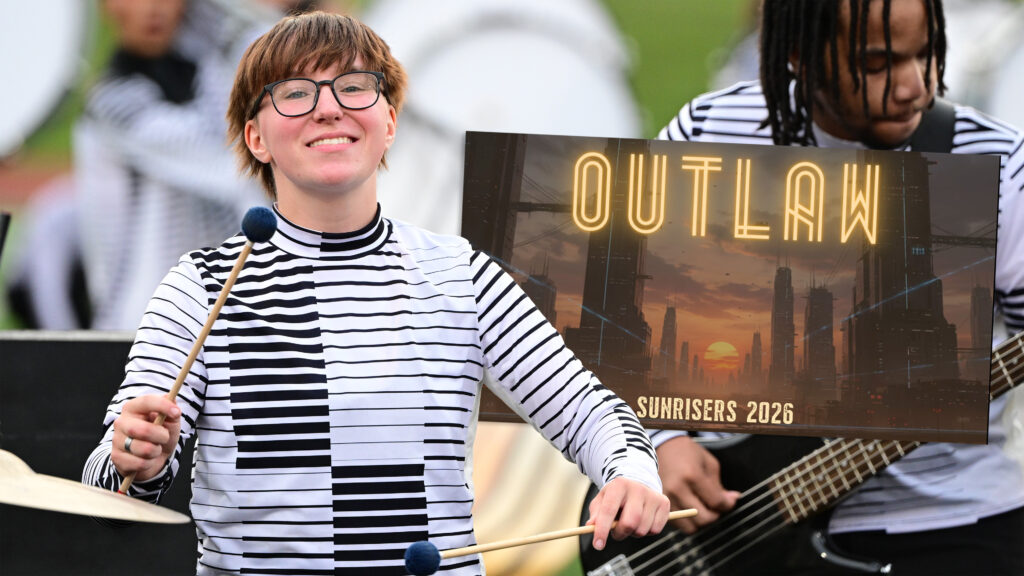For the first time in Drum Corps International history, nine corps scored above 90 points during the 1992 DCI World Championship Finals in Madison, Wisconsin.
The temperature at the University of Wisconsin’s Camp Randall Stadium plummeted into the 40s during the event, making it among the coldest Finals-night competitions since 10 years earlier in Montreal.
Other firsts this year included the Blue Knights being among the corps to break 90 points, Crossmen placing among the top-six corps, Blue Devils introducing a coed color guard, and Cavaliers winning its very first DCI World Championship title.

Star of Indiana’s “American Variations” aimed straight at the heartstrings of audience members with musical references to patriotic songs and a series of props that featured semi-transparent scrims with scenes of Americana.
The production started with Morton Gould’s “Star Spangled Overture.” The piece is the first movement from his 1976 suite, “American Ballads,” a set of reworked American patriotic tunes commissioned for the nation’s Bicentennial by the Queens Symphony Orchestra. Gould had grown up in Queens, had his first composition published at the age of six, and as a 19-year-old, was hired as staff pianist by Radio City Music Hall when the venue first opened in 1932.
Shimmering blue sashes worn by the brass players and percussionists were combined with red jackets and white pants to drive home the patriotic theme. To add to the shimmer, color guard members utilized spinning “coins” (introduced by the corps in 1991), to create a flashing sparkle that accompanied the continual and unmistakably quotations of the national anthem.

At the end of a quieter musical segment, color guard performers briefly revealed red and white stripes on the inside of their blue blouses, completing the allusion to an American flag. A raucous swirl of music and drill formation evolutions ended the piece with the sudden appearance of a large star, referencing the stars on the flag as well as the corps’ name.
Next the corps programmed William Schuman’s orchestral rendition of “Chester,” which is the third and final movement of his “New England Triptych.” The piece was written in 1956-57 and is based on an anthem by William Billings that expressed desire for freedom from the British Crown. Billings, who is often regarded as America’s first choral composer, wrote the tune for a 1770 songbook, subsequently achieving popularity with the Continental Army during the American Revolution.
Like Gould, Schuman grew up in New York City and started his composing career quite young. He served as President of the Juilliard School and directed the creation of the Lincoln Center for the Performing Arts, for which he also served as President.

Star of Indiana began the piece with the opening chorale of the Schuman rendition, followed by a fast flurry of notes introduced by a single drummer playing what appeared to be a traditional rope snare drum. It ended with an American flag presentation and with color guard performers unveiling giant silks styled after an abstraction of the American flag.
“Amber Waves” was the second of six movements of Morton Gould’s “American Ballads,” based on “America the Beautiful,” a patriotic tune composed by church organist and choir director Samuel Ward in 1882. The lyrics that most American children learn in school were written by songwriter Katherine Lee Bates in 1895, though it wouldn’t be until 1910 that Ward’s music was combined with Bates’ lyrics and published as “America the Beautiful.” Gould wrote that he was moved by the sounds and images of the patriotic song as a schoolchild.
This beautiful ballad opened on the football field with three large silks surrounding a horn soloist, each of a color mentioned in the opening lyrics of “America the Beautiful;” blue for spacious skies, amber for waves of grain, and purple for mountains majesty.

Drum line members performed pantomime behind a large scrim emblazoned with sheaves of grain, followed by others pantomiming in mirror image in front and in back of a longer scrim painted with an image of the Golden Gate Bridge. Two more scrims featured sights of large western rock outcroppings and mountains.
Additionally, large silks floated across the field with images of foreign flags, representing the immigrants who built America. The emotional climax of the music featured the unveiling of a scene depicting the face and torch of the Statue of Liberty on the 50-yard line, leading to a stylized rendition of the American flag floating behind the scrim.
The final piece of music was Gordon Jacob’s “Flag of Stars,” commissioned in 1954 by a band fraternity at the University of Louisville. Jacob was born in London in 1895 and was captured by the Germans during World War I, becoming one of only 60 members of his 800-man battalion to survive. Later, he studied with the famed Ralph Vaughan Williams and developed a style more in tune with the conservative styles that preceded him. Jacob wrote to the fraternity, “The allegro is prompted by thoughts of the energy, vitality and cheerfulness of the American people—young, optimistic, and full of their faith in their destiny.”
The flags utilized during this section were of a number of pastel colors with an abstracted star at the center. A company front push by the brass section featured a quotation from “The Star Spangled Banner,” as the color guard unveiled transparent images of the American flag.
The brass players then spelled out “USA” and collapsed into a block star formation. But with just seconds remaining, the fireworks weren’t yet over. The guard, dressed in blue and spinning the “coins” from earlier, maneuvered into the upper left corner of a block form filled in by the horns and drums, creating a massive moving American flag. The entire corps disappeared behind the largest see-through scrim of the show, the Statue of Liberty looking out over fireworks.
This scrim, perhaps the tallest set to ever be seen on a drum corps field, was unveiled only for the corps’ Finals-night performance and came as a shocker to an audience long expecting surprises from the corps.
Still, to some, the entire production seemed far more traditional than the styles the corps had previously been exploring. Those fans had only to wait one more season for Star of Indiana to come out with its spectacularly abstract “Medea” show, which turned the marching music activity upside-down during what became the corps’ last season on the field in 1993.
1992 Overview

Michael Boo was a member of the Cavaliers from 1975-1977. He wrote about the drum corps activity for more than 35 years while serving as a staff writer for various Drum Corps International projects. During his lifetime Boo wrote for numerous other publications including an honors-winning book on the history of figure skating. He also was an accomplished composer. Boo passed away in 2020 and was inducted into the DCI Hall of Fame posthumously in 2021.





